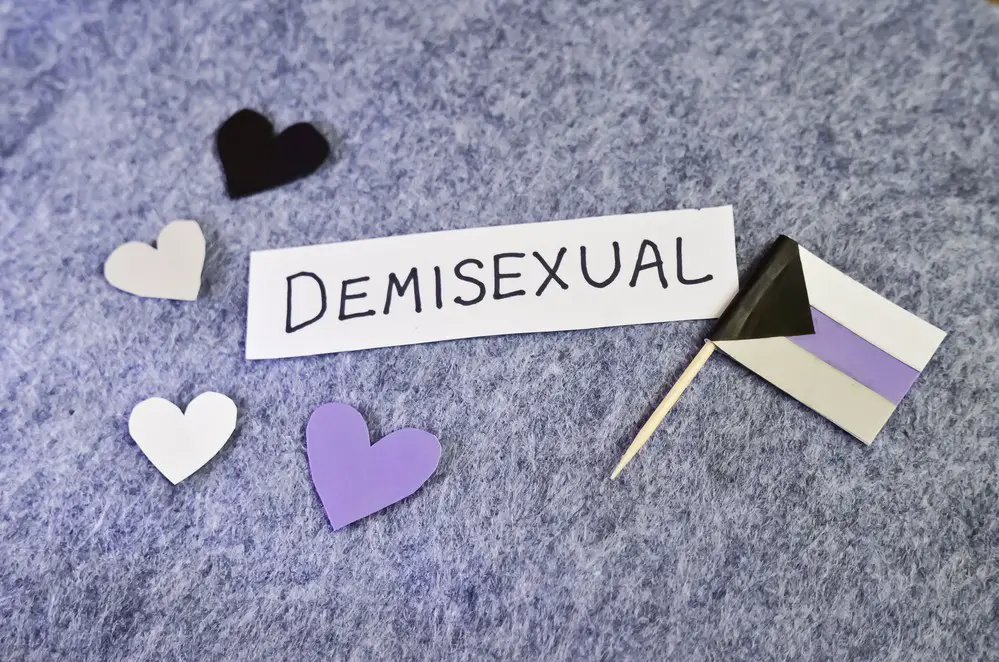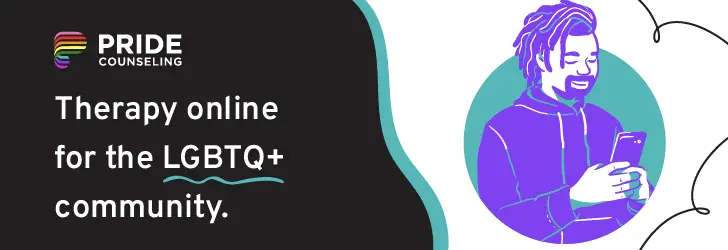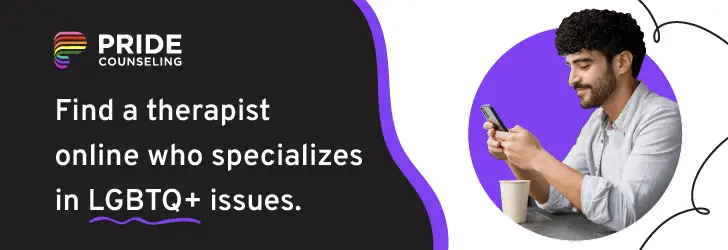As a BetterHelp affiliate, we receive compensation from BetterHelp if you purchase products or services through the links provided
Understanding one’s romantic and sexual identity can be a complex journey, and within the LGBTQIA+ community, various labels and terms help individuals express and identify their orientations. One such term is panromantic demisexual, which combines the concepts of panromanticism and demisexuality.
Panromantic individuals can feel romantic attraction regardless of gender, experiencing love, affection, and attraction to any gender identity. Demisexuality, on the other hand, refers to a person who only experiences sexual attraction once a strong emotional bond has been established. Combining these terms, a panromantic demisexual experiences romantic attraction to all genders, but sexual attraction only occurs after forming a deep emotional connection.
Being panromantic demisexual offers unique perspectives in relationships and personal identity, emphasizing the importance of emotional bonds in romantic and sexual connections. Learning about this orientation helps promote understanding and acceptance within and beyond the LGBTQIA+ community.
Key Takeaways
- Panromantic demisexuals experience romantic attraction to all genders and sexual attraction only after forming a strong emotional bond.
- Understanding this orientation highlights the importance of emotional connections in relationships.
- Exploring and identifying panromantic demisexuality fosters acceptance within the LGBTQIA+ community and beyond.

Understanding Key Terminologies
When discussing panromantic demisexuality, you must familiarize yourself with key terms relevant to this topic. Let’s break them down into simpler concepts:
Gender: Gender refers to the social, cultural, and psychological aspects of being male, female, or non-binary. It differs from one’s biological sex based on an individual’s physical characteristics.
Pansexual: Pansexuality, as a sexual orientation, means being sexually attracted to people, regardless of gender. Pansexual individuals can experience attraction to individuals of any gender identity.
Panromantic: Similar to pansexuality, the term panromantic refers to a romantic orientation that involves experiencing romantic attraction or emotional connections to people of all genders. It highlights that any specific gender identity doesn’t bind love, affection, and attraction.
Demisexuality: Falling within the asexuality umbrella, demisexuality is a sexual orientation in which a person experiences sexual attraction only when they have a strong emotional bond with someone. It emphasizes the importance of emotional connections in developing sexual attraction.
Gender identity refers to an individual’s psychological identification with a specific gender. Gender identity might not necessarily align with the person’s assigned sex at birth; it can be male, female, neither, or something entirely different.
Umbrella term: In the context of sexuality and orientation, an umbrella term is a collective phrase used to describe a range of similar identities or experiences. For instance, asexuality is an umbrella term that includes demisexuality as one of its aspects.
Now that you’ve grasped these key terminologies, you can better understand panromantic demisexuality and appreciate its unique characteristics. At the core, this identity emphasizes the importance of emotional connections and a broad acceptance of varied gender identities in love, attraction, and relationships.

Defining Panromantic Demisexual
Panromantic demisexuality is a unique romantic and sexual orientation that combines two distinct aspects: panromanticism and demisexuality. It’s important to understand the individual aspects to grasp the concept of panromantic demisexuality fully.
Panromantic refers to an emotional orientation where a person experiences romantic attraction or love for people of all genders, regardless of sex or gender. It emphasizes the emotional connection someone might feel toward another person without addressing any physical attraction.
Demisexual, on the other hand, is a sexual orientation where a person only experiences sexual attraction after forming a deep emotional bond or connection with someone. It is not about preference but rather a unique way an individual may approach sexual attraction.
Now, when you combine these two concepts, you get panromantic demisexual. A person with this orientation experiences romantic attraction to people of all genders and only develops sexual attraction after creating a strong emotional connection.
Remember that emotional connections are the foundation for panromantic demisexuals. They pursue relationships based on comfort, understanding, and shared experiences, regardless of their partner’s gender identity. These connections create the groundwork for potential sexual attraction for them.
In conclusion, panromantic demisexuality is a beautiful and nuanced romantic and sexual orientation that focuses on the importance of emotional bonds, transcending gender barriers, and celebrating love in all its forms. Remember, everyone has their unique experience of love and attraction, and understanding these differences brings us closer to appreciating the rich spectrum of human emotions and relationships.
Difference in Orientations
Regarding emotional and sexual interactions, there’s quite a spectrum of different orientations. Let’s delve into some of the most common ones to understand their unique characteristics.
Heteroromantic and Biromantic: As a heteroromantic individual, you would feel romantic attraction towards people of the opposite gender. On the other hand, biromantic folks can be romantically attracted to people of both their own and other genders.
Aromantic, Demiromantic, and Polyromantic: Feeling little or no romantic attraction, regardless of gender, defines your experience if you’re aromantic. Demiromantic individuals only experience romantic attraction after forming a strong emotional bond. Meanwhile, polyromantic individuals experience romantic attraction toward multiple, but not necessarily all, genders.
Now, let’s look at a few sexual orientations.
Heterosexual, Bisexual, and Homosexual: Heterosexual people feel sexually attracted to individuals of the opposite gender, while bisexual individuals are sexually attracted to people of both their own and other genders. Homosexual people experience sexual attraction towards individuals of the same gender.
Asexual: As an asexual person, you don’t experience sexual attraction towards anyone, regardless of gender. This orientation focuses purely on the emotional and affectionate aspects of relationships.
Regarding relationship styles, monogamy is the most traditional and widely accepted approach, where you commit to an exclusive relationship with one partner at a time.
In panromantic demisexuality, it’s important to remember that panromantic refers to a romantic orientation that allows for romantic attraction to people of any gender. In contrast, demisexuality involves experiencing sexual attraction only after forming a strong emotional bond. These orientations can combine, overlap, or vary, reflecting human relationships’ diverse and fluid nature.

Panromantic Demisexual Relationships
Navigating panromantic demisexual relationships can be rewarding if you maintain open communication and set clear boundaries with your potential romantic partners. In these relationships, you can feel romantic attraction regardless of gender, but sexual attraction arises only after forming a significant emotional bond.
Communicate your feelings and needs to your partner to have healthy, long-term relationships. This is important, as it helps both of you understand each other’s emotional and sexual needs. Some key tips for effective communication include:
- Regularly check in with your partner about your feelings and emotions.
- Listen actively to your partner’s thoughts and feelings without judgment.
- Practice empathy and try to understand your partner’s perspective.
Boundaries are crucial for maintaining balance and harmony in panromantic demisexual relationships. Here are some suggestions for setting up healthy boundaries:
- Discuss your preferences and limits surrounding physical touch or intimacy.
- Establish emotional boundaries around topics or situations that make you uncomfortable.
- Create shared expectations about the level of commitment and exclusivity in your relationship.
Being honest with potential romantic partners about your panromantic demisexual orientation ensures that both parties understand the nature of the connection. Transparency can help you avoid misunderstandings and foster a deeper emotional connection, which may eventually lead to a strong and enduring bond.
Remember to approach relationships with an open mind and embrace the uniqueness of your panromantic demisexual orientation. You can foster a loving and fulfilling partnership built on mutual understanding and respect by providing open communication and setting clear boundaries.
Gender Identities and Labels
When understanding and respecting various gender identities, it’s essential to recognize the diverse range of labels people use to express themselves. Panromantic demisexuality addresses both sexual and romantic orientations, offering inclusivity to individuals of all genders.
Panromantic Demisexuality is a term that reflects a person who experiences romantic attraction to all gender identities and expressions but only feels sexual attraction when they’ve formed a strong emotional connection with someone. It’s a combination of two elements – panromanticism and demisexuality.
To give you a clearer understanding, let’s briefly explore other relevant labels and orientations:
- Pansexuality refers to individuals who are sexually attracted to others, regardless of their gender identity or expression.
- Asexuality is when someone doesn’t experience sexual attraction at all. However, they can still have romantic feelings for others, just like panromantics.
- Homoromantic individuals experience romantic attraction solely to people of the same gender.
- Polysexual people are attracted to multiple, but not all, genders.
These labels are only a few examples that illustrate the complexity and diversity of human attraction and relationships. Recognizing these differences can help you better understand the unique experiences of those around you.
In conclusion, embracing the various terms and labels associated with different gender identities and sexual or romantic orientations helps promote inclusivity and better understanding. By familiarizing yourself with these concepts, you show respect and support for people of all genders and expressions.
 Misconceptions and Stereotypes
Misconceptions and Stereotypes
Panromantic Demisexuals are Picky or Frigid
One common stereotype about panromantic demisexual individuals is that they are picky or frigid regarding their relationships. However, this misconception connects their willingness to engage in sexual activity to their orientation. The truth is that demisexuals are not picky or frigid; they don’t experience sexual attraction without an emotional bond.
Demisexuals are Prudish or Sex-Averse
Some people believe that demisexuals are prudish or sex-averse because they require a deep emotional connection before experiencing sexual attraction. It’s important to remember that demisexuality is an identity relating to sexual attraction, not a statement about someone’s openness to engage in sexual activities. Demisexuals can and do enjoy sex, but their sexual attraction is closely tied to their emotional connections.
Unfaithfulness and Panromantic Relationships
Since panromantic individuals are attracted to people of any gender, there is a misconception that they may be more likely to be unfaithful in a romantic relationship. However, the capacity to be attracted to people of all genders doesn’t increase the likelihood of infidelity. Panromantic individuals seek fulfilling, healthy, and committed relationships based on trust and respect.
Key Takeaway: Don’t ignore the misconceptions and stereotypes surrounding panromantic demisexuality. Always remember that individuals’ experiences in relationships are based on their unique personalities and desires, and generalizations don’t do justice to the richness and variety in our lives.
Navigating the Spectrum: A Checklist for Identifying as Panromantic Demisexual
Have you ever wondered if you or your partner might be panromantic demisexual? It’s a unique intersection of emotional and sexual attraction, and recognizing it can be liberating. Use this checklist to explore your feelings; it’s like a compass for your emotional geography.
Checklist for You:
- All-Inclusive Love: You experience romantic attraction to individuals, regardless of their gender.
- Deep Dive Required: You only develop sexual feelings after forming a significant emotional bond.
- The Gender Blur: When imagining future relationships, gender doesn’t play a decisive role for you.
- Heart Over Hormones: You prioritize emotional connection over sexual chemistry.
- Introspection: You’ve spent time self-reflecting on your orientation and how it affects your relationship choices.
Checklist for Your Partner:
- Open-Hearted: Your partner is comfortable and open about their romantic attraction to multiple genders.
- Soul First, Body Second: Sexual attraction occurs only after a deep emotional connection.
- Fluid Fantasies: Your partner’s idea of an ideal relationship doesn’t hinge on gender norms.
- Tuned In: Emotional understanding and intimacy are must-haves for them.
- Open Dialogues: They’ve communicated openly about being panromantic demisexual or showing signs that align with it.
Points to Ponder:
- If many of these points resonate, you or your partner may identify as panromantic demisexual.
- These are not strict rules but rather indicators. Everyone’s experience is personal and unique.
- Take your time in this journey of self-discovery; there’s no rush to put a label on yourself or your partner.
Unfurling the nuances of being panromantic demisexual can be like plotting a course on a newly discovered map. The more you understand, the more confidently you can journey through the diverse landscapes of love and attraction.
Coming Out
When you’re ready to come out as panromantic demisexual, it’s important to have a plan in place. Consider the following tips to help you navigate this journey with ease and grace:
- Choose your audience wisely: Come out to people you trust and know will be supportive, such as close friends or family members. This will give you a sense of security and boost your confidence when talking to others.
- Pick the right time and place: Find a comfortable and private setting to have this conversation. Ensure you and the person you’re talking to have enough time for thoughtful discussion.
- Be prepared for questions: People might not be familiar with panromantic demisexuality, so be open and patient when responding to their questions. Having resources or examples to share can help explain your identity.
- Emphasize the need for respect: Regardless of whether someone fully understands your identity, they should respect it. Emphasize the importance of using correct pronouns and being mindful of your boundaries.
- Expect various reactions: People may react differently to your coming out. It’s essential to remember that everyone is entitled to their feelings and that it might take time for some people to accept and understand your identity fully.
- Offer support to others: After coming out, it can be helpful to join support groups or online communities where you can discuss your experiences and connect with others who share your identity.
By following these tips, your coming out journey as a panromantic demisexual will be a smoother and more authentic experience. Remember, it’s essential to be true to yourself, and ultimately, the people who matter the most will love and respect you for who you are.
In the Context of LGBTQIA+
When discussing panromantic demisexuality, it’s important to understand its place within the LGBTQIA+ community. LGBTQIA+ stands for lesbian, gay, bisexual, transgender, queer or questioning, intersex, and asexual. The “+” symbol includes other identities and allies within this diverse community.
Panromantic demisexuality is a unique combination of romantic and sexual orientations. A panromantic individual experiences romantic attraction to people of all genders, whereas a demisexual person only feels sexual attraction once they’ve formed a strong emotional bond with someone.
As such, within the scope of LGBTQIA+, panromantic demisexuality occupies a valuable space, emphasizing the nuances and complexities of a person’s experiences with attraction and relationships. Groups like the Asexual Visibility and Education Network (AVEN) and GLAAD work to raise awareness about and support these various identities, including panromantic demisexuality.
Here are a few points to keep in mind when discussing panromantic demisexuality in relation to the LGBTQIA+ community:
- Panromantic demisexuality is a unique intersection of romantic and sexual orientations, highlighting community diversity.
- Recognizing and understanding this identity is essential to promote inclusivity and representation in the LGBTQIA+ community.
- Groups, such as AVEN and GLAAD, play a vital role in raising awareness, support, and education about various identities, including panromantic demisexuality.
Remember, being aware of the variety of identities within the LGBTQIA+ community allows for a more inclusive, understanding, and supportive environment for everyone. By acknowledging and discussing panromantic demisexuality in this context, you’re helping to create a more inclusive and compassionate world.
Beyond the Sexual Spectrum
As you navigate the realm of human emotions and attractions, it’s essential to understand the various points on the sexuality spectrum. One fascinating aspect of the spectrum is panromantic demisexuality, which combines two unique orientations – panromantic and demisexual. Let’s dive into the meaning behind this intersection and how it impacts potential partners and relationships.
First, let’s examine the panromantic aspect of this orientation. Panromantic individuals can experience romantic attraction to people across the gender spectrum. This means they can potentially fall in love with men, women, and non-binary individuals, among others. It’s crucial to note that panromanticism focuses on romantic feelings rather than just sexual attraction.
Demisexuality, on the other hand, involves forming a strong emotional bond with someone before experiencing sexual attraction. Unlike the famous concept of “love at first sight,” demisexual people don’t feel instant sexual chemistry with potential partners. Rather, they need time to build an intimate connection before feeling that deep physical pull.
These two fascinating aspects combine to create panromantic demisexuality. Individuals who identify this way can develop deep affectionate feelings for anyone, regardless of gender, but they won’t be sexually attracted until a strong emotional bond is established.
A concept that helps clarify the divide between romantic and sexual attraction is the split attraction model. This model acknowledges that people can have different preferences and needs regarding the two types of attraction. For panromantic demisexual individuals, this distinction is incredibly relevant, as they can navigate the complexity of their feelings for various partners more effectively.
Some people might identify as graysexual, distinguishing between demisexuality and traditional sexual orientations. Graysexual individuals experience infrequent or fluctuating levels of sexual attraction, which can provide more nuance to their relationship experiences.
Remembering these crucial distinctions on the sexuality spectrum can help individuals like you understand and appreciate the mosaic of human emotions and connections more in-depth and compassionately. By considering the intricacies of panromantic demisexuality, you can embrace the fluidity and dynamism of your feelings and support others in their unique journeys of self-discovery.
Find Your Tribe at Pride: Embrace, Empower, and Celebrate Love Today!”

Charting Emotional Waters: When to Seek Therapy for Panromantic Demisexuality
Navigating your romantic and sexual identity isn’t always a walk in the park. Sometimes, it’s like sailing through foggy waters, uncertain about the next wave. If you find that being panromantic demisexual raises more questions than answers, or if you’re grappling with loneliness, anxiety, or internalized stigma, it might be a sign that you should seek professional guidance.
Signs it’s Time to Seek Therapy:
- Persistent confusion or distress about your orientation
- A significant impact on your relationships due to misunderstandings or miscommunications
- Emotional exhaustion from constantly having to explain your identity
- Internalized homophobia or stigmas affecting your well-being
- You find it challenging to form the deep emotional bonds crucial for your orientation
Your Personal Roadmap: Goals and Signs of Progress
Therapy can offer a personal roadmap to self-discovery and acceptance. The destination is yours to decide, but there are some common milestones to look out for:
Goals:
- Developing a clear understanding and acceptance of your identity
- Learning communication strategies to discuss your orientation with loved ones
- Strengthening emotional bonds and relationships
- Achieving a better balance between your emotional and sexual desires
Signs of Progress:
- You feel more confident discussing your orientation
- Your relationships are deepening and becoming more authentic
- A decrease in feelings of isolation or stigma
- Better emotional well-being and less anxiety about your orientation
Pride Counseling: A Safe Harbor for Exploration
Pride Counseling (a division of BetterHelp) offers a non-judgmental space tailored specifically for LGBTQIA+ individuals. Imagine it like a harbor where you can dock your ship, work on your navigational skills, and get ready to sail again. Counselors understand the unique challenges and joys of being part of the LGBTQIA+ community, including the intricacies of being panromantic demisexual. Here, you can set your sails toward emotional freedom and authentic relationships, equipped with professional insights.
Remember, love is a vast ocean, and no two voyages are alike. Whether sailing solo or with a fleet, you deserve to navigate with clarity and pride.
Frequently Asked Questions
What is the difference between panromantic and pansexual?
Panromantic and pansexual describe different aspects of a person’s identity. Panromantic refers to the ability to form romantic connections with people of any gender, whereas pansexual refers to the ability to experience sexual attraction to people of any gender. They can overlap, but they don’t always go hand in hand.
Key takeaway: Panromantic focuses on romantic attraction, while pansexual focuses on sexual attraction.
How does demisexuality differ from asexuality?
Demisexuality and asexuality are two different sexual orientations existing within the asexual spectrum. Asexuality is characterized by a lack of sexual attraction to others, but that doesn’t mean asexual individuals can’t form strong emotional bonds. Demisexuality, on the other hand, refers to those who experience sexual attraction only after forming a strong emotional connection with someone.
Key takeaway: Asexual people don’t experience sexual attraction, while demisexual people experience sexual attraction after forming a deep emotional bond.
Can you be demiromantic without being demisexual?
Yes, it’s possible to be demiromantic without being demisexual. Demiromantic individuals experience romantic attraction only after forming a strong emotional bond with someone. This doesn’t necessarily dictate their sexual attraction, which may be separate from their romantic feelings.
Key takeaway: Being demiromantic doesn’t automatically mean being demisexual as well.
What does it mean to identify as panromantic demisexual?
Identifying as panromantic demisexual means that an individual can form romantic connections with people of any gender (panromantic) but only experiences sexual attraction after developing a deep emotional bond with someone (demisexual). This combination of panromantic and demisexual reflects the romantic and sexual dimensions of a person’s identity.
Key takeaway: Panromantic demisexual individuals have a broad scope of romantic attraction and require an emotional connection for sexual attraction.
How can I tell if I might be panromantic?
If you find that your romantic connections are formed based on a person’s personality and your emotional bond with them rather than their gender, you might identify as panromantic. Reflect on past relationships and attractions to see if this pattern rings true. Remember, only you can accurately determine your romantic orientation.
Key takeaway: To determine if you’re panromantic, consider if your romantic connections are formed regardless of a person’s gender.
What is the meaning of the panromantic flag?
The panromantic flag represents the panromantic community and its unique identity. It consists of five horizontal stripes in shades of blue, yellow, and pink, symbolizing the diversity of gender identities and expressions that panromantic individuals can be romantically attracted to. The flag is often used during pride events, online forums, and as a way for panromantic individuals to express their identity.
Key takeaway: The Panromantic flag is a symbol that celebrates the diverse range of romantic attractions within the Panromantic community.
From Soul-Searching Walks to Witty Words: Meet Jacob Maslow
Hey there, I’m Jacob Maslow, and yes, my life is a rich tapestry of triumphs and challenges. A veteran in the therapy room, I take Lexapro like I take my morning coffee consistently and with a sense of gratitude. Each day, I embark on long, soul-cleansing walks, a ritual that keeps my mind as clear as a summer sky.
With a past mired in a tumultuous relationship with an ex who made narcissism an art form, I’ve danced through the darkest corridors of mental health. The court battles and severed ties have been tough, but they fuel my work, turning my journey into a path of enlightenment for others.
I use my pen as a sword, cutting through the haze of mental health stigmas and narcissistic tendencies. From my legal website to my articles, I guide others wrestling with uncooperative spouses and weaponized family dynamics. I believe mental health issues aren’t life sentences—they’re merely chapters in your epic tale.
So, let’s flip the page together. I’m living proof of that because anyone can conquer their inner demons.
- 3 Ways Wearing a Hat Can Help Lower Your Stress Levels - April 19, 2025
- Breaking the Silence: Why Men’s Mental Health Matters More Than Ever - April 15, 2025
- How to Transform a Home’s Patio Space into a Relaxing Space - March 23, 2025
This site contains affiliate links to products. We will receive a commission for purchases made through these links.


 Misconceptions and Stereotypes
Misconceptions and Stereotypes



